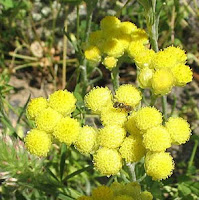- by Debra Anchors
 |
| Everlasting Harvest |
I admire those clever crafters who with silica crystals, borax and microwaves can transform virtually any flower so you’d swear it was still alive. Personally, I lack not only the skills for such work but also the dedication. That’s why I am content with “everlastings”, the flowers I can dry in a single step and without extensive knowledge of chemistry.
Strictly speaking, the name ‘everlastings’ applies only to members of the family Inuleae, relatives of sunflowers and strawflowers. However, in the interest of practicality, I’d vote to extend this category to include any flower with a tightly constructed, papery flower head which, if cut at the proper stage of maturity, will keep its structure and perhaps its color as it dries.
 |
| Pearly Everlasting |
 |
| Larkspur |
Preparation and Planting –
Not surprisingly, my loosely defined group includes plants of all sorts – annuals, perennials, biennials and ornamental grasses. They are sun-lovers that require at least six hours of sun daily (money plant is a notable exception, as it thrives more in the shade). Everlastings also require well-drained and reasonably fertile soil. A slightly acidic to neutral pH is best. Dig the soil for the garden deeply, turning the soil to a depth of at least 14 inches while mixing-in a couple of inches of compost.
You can satisfy your desire for everlastings by planting one or two rows at the edge of your herb garden. But, if you’re feeling more ambitious, you can instead plant a separate garden dedicated to everlastings. Plan this for aesthetics as well as utility and this garden can be attractive in its own right, even before you dry it and transfer it to vases. Your garden center staff will be very helpful as you choose the best plants for your site.
Proper planning is essential for ease of maintenance. For example, allot separate growing areas for annual and perennial plants. The two groups have very different needs – perennials perform best if given just enough water and fertilizer, whereas annuals need to be fed and irrigated more generously. Besides, the digging and replanting that annuals require can be done more efficiently if you aren't tiptoeing around perennials. Keep in mind the plants’ relative heights when you arrange them within the garden, too.
 |
| Lavender |
 |
| Statice |
Harvest and Drying –
The standard advice for harvesting most cut flowers is to take them in the early morning while the dew is still on them and the plants are full of water. Commonly, flowers are cut before full maturity so the buds can finish unfolding in the vase. But, when it comes to everlastings, you should ignore the standard.
If you cut everlastings when they're wet, they are likely to discolor as they dry. And, because the drying halts any further development of the blossoms, you should cut the flowers at the stage at which you want them to remain. In most cases, this will be when the flowers are fully bloomed but still fresh and at full color.
Harvesting is straightforward. Cut the flowers with a sharp pair of scissors and strip the leaves from the stems. Then, with rubber bands, fasten them together in small bundles of 25 stems or so, segregating the different species into separate bundles. Hang the bundles upside-down (so that gravity will keep the stems straight) in a dark, warm and dry spot where the temperature stays between 70° and 90° F. You will know the flowers are dry when a bent stem breaks with a snap. At that point, arrange the everlastings in vases or stow them in boxes with a cedar block (or a pinch of cedar shavings) in a cooler but still dry spot. The cedar will deter insects.
 |
| Globe flower |
 |
| Immortelle |
Everlasting Flowers that keep their color when dried:
Everlasting (annual)
Globe flower (annual)
Immortelle (annual)
Larkspur (annual)
Lavender (perennial)
Love-lies-bleeding (annual)
Mealy-cup sage (perennial)
Statice (annual and perennial species)
Strawflower (perennial grown as an annual)
Yarrow (perennial)
Everlasting Flowers that lose their color when dried:
Baby’s breath (annual and perennial species)
Globe thistle (perennial)
Grasses, annual – Canary grass, Foxtail millet
Grasses, perennial – Squirreltail grass, Pampas grass,
Money plant (biennial)
Sea holly (perennial)
Strawflower (annual)
 |
| Yarrow |
 |
| Mealy-cup sage |
 |
| Strawflower |
 |
| Love-lies-bleeding |
Thank you for stopping by and spending a little time with me. If you enjoyed this article, please post a comment so I will know. I will be delighted if you would suggest Gardens Inspired to your friends, follow me or subscribe to my Blog.
Leave a legacy, but garden like you’ll live forever!
-Debra
If you 'like' this post, please click the Google +1 box, below.

WOW! I had no idea there were so many! Thanks for the insight.
ReplyDelete